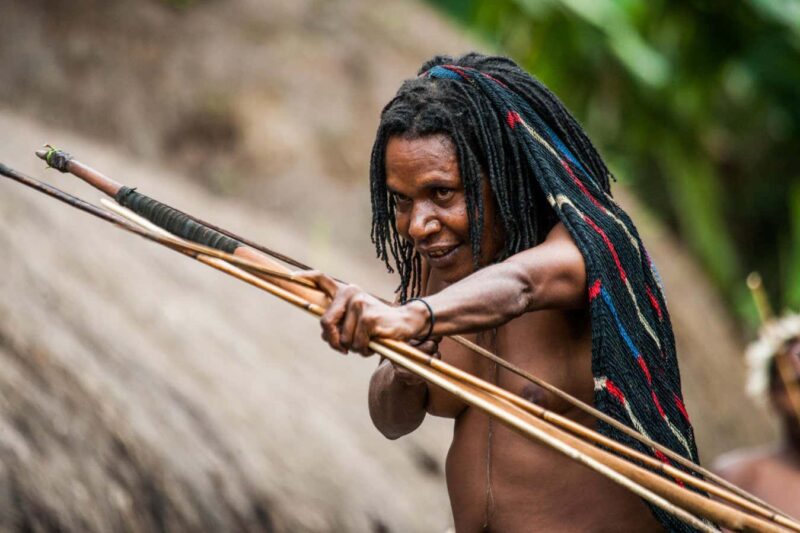A woman from the Dani tribe in Indonesia with a bow and arrow
ANDREY GUDKOV/Alamy
A recent review of foraging societies around the world has revealed that the idea that men hunt while women stay at home is almost completely wrong. In fact, women participate in hunting in 80 per cent of the societies examined. Furthermore, in a third of these societies, women were found to hunt big game, which includes animals heavier than 30 kilograms, as well as smaller animals.
Cara Wall-Scheffler, an anthropologist at the University of Washington in Seattle, states that these findings are likely to be representative of all foraging societies throughout history. By sampling nearly 150 years of ethnographic studies from every continent, including multiple cultures, the researchers believe they have obtained a comprehensive understanding of hunting practices across the world.
Previous evidence already indicated that women hunted in many cultures in the past. For example, a study conducted in 2020 found that nearly half of the individuals buried with hunting weapons in the Americas were women. However, researchers have been hesitant to acknowledge these women as hunters due to the prevailing belief that men are the hunters while women are not.
Wall-Scheffler’s team utilized the D-PLACE database, which contains records on over 1400 human societies worldwide spanning the past 150 years, to examine data on hunting in foraging societies. Out of the 63 societies included in the analysis, 50 reported women participating in hunting.
For 41 of these societies, there was information available regarding whether women’s hunting was intentional or opportunistic. Surprisingly, 87 per cent of cases indicated that women’s hunting was intentional. Wall-Scheffler expressed her surprise at this high percentage.
The researchers also analyzed data on the size of animals hunted by women, which was recorded for 45 societies. The findings revealed that 46 per cent of cases involved hunting small game such as lizards and rodents, 15 per cent involved medium game, and 33 per cent involved large game. In 4 per cent of the societies, women hunted game of all sizes.
A notable finding from the analysis was that women’s hunting strategies were more adaptable compared to men’s. Women utilized a wider range of tools and often went hunting with various companions, including male partners, other women, children, or dogs. While the bow and arrow was a commonly used tool by female hunters worldwide, women were also skilled in using knives, nets, spears, machetes, crossbows, and more.
Wall-Scheffler suggests that this greater flexibility in hunting practices among women might be due to variations in mobility during pregnancy or breastfeeding. In some cases, women hunted while carrying babies on their backs. Additionally, certain societies imposed taboos on women making or using specific tools or weapons, which forced them to find alternative methods.
Randy Haas, an expert in hunter-gatherer archaeology at Wayne State University in Michigan, described this paper as a much-needed meta-analysis. He believes that the findings, combined with related archaeological discoveries, convincingly demonstrate that the division of subsistence labor is much more diverse than previously believed.
Despite the overwhelming evidence that women have always participated in hunting activities, Wall-Scheffler is puzzled by the persistence of the misconception that only men are hunters. She finds it equally remarkable that women with babies on their backs are able to engage in hunting.
Topics:








